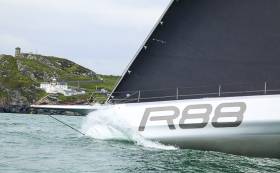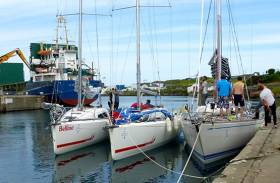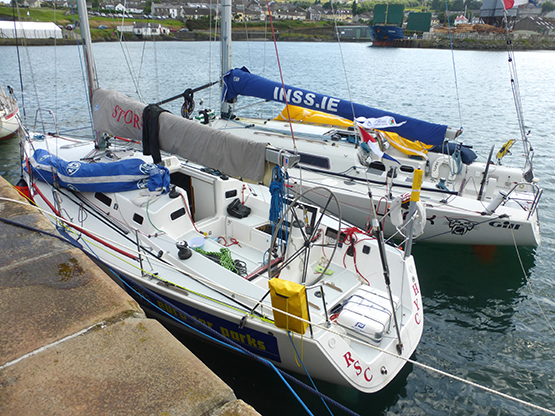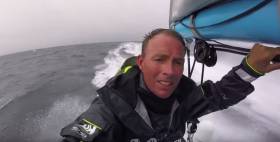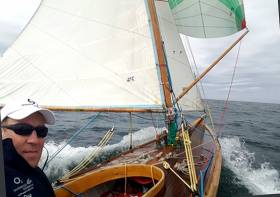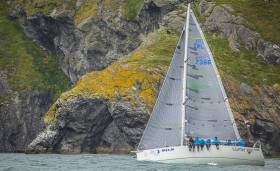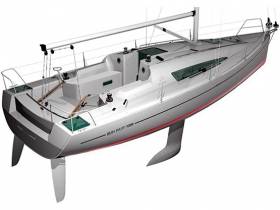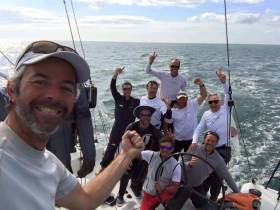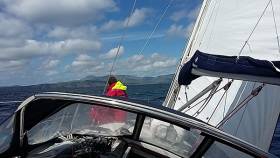Displaying items by tag: Round Ireland
Being a maritime correspondent can be encouraging, disheartening and frustrating.
Preparing the current edition of THIS ISLAND NATION I experienced those emotions.
I heard a sailor praise the coastal communities he had met during a 42-day voyage around Ireland. He described them as the “most wonderful people who are essential to this island nation.”
I also talked to a fisherman, trying to ensure the future of his community, describe the dismissive, discourteous attitude of State agencies.
I stood at the evocative memorial to those lost at sea in Dunmore East fishing port in County Waterford, where a fisherman pointed out to me the names of those of his family who had died in marine tragedies. He told me that visitors to coastal areas wanted to see fishing boats, not yachts at marinas.
I was the only journalist on the pier at Schull in West Cork on Saturday afternoon when Gary Sargent completed his ‘one wild ride’ on a Laser around Ireland. The general media didn’t show much interest..
Gary learned a lot about coastal communities during his voyage, which started an ended at Schull in West Cork: “They are wonderful people who commit themselves to helping you. It was an eye-opener, a lesson for me, from Dublin, showing me how vital these communities are to this island nation. We are blessed with wonderful coastal people, whom we should respect and value. We have an amazing coastline and eco system that we should get out and see more of. I have learned so much about respecting the water.”
On his voyage, he capsized four times. “It was mentally harder than physically. There was the challenge of getting into the boat in a wet suit every day, no matter what the weather and no matter how I felt.”
• Listen to Gary describe his voyage on the programme below and about the garden mats which were a vital part of his equipment
I interviewed Sean Doherty, a fisherman from Cheekpoint on the Suir Estuary who told me that he fears children in coastal communities will not know the history or heritage of their communities which are being destroyed by Government neglect, he said. His interview is a salutary contrast to what Gary Sargent experienced amongst the coastal communities. Sean Doherty outlines how his community put a lot of time and effort into submitting plans for the future of their communities, but after a year of waiting for response, they have heard nothing.
That is unacceptable and appears to indicate a dismissive attitude towards coastal communities.
• Listen to Sean Doherty on the programme
Also in the past week, the latest figure for the value of catches which European Union fishing nations, other than Ireland, take from Irish waters every year was put at €4 billion by the Irish Fish Producers’ Organisation That is a huge loss to the Irish economy and is a transfer of wealth from Ireland, an effective contribution to the EU about which very little has ever been said in public by the Government or the national media.
At the same time there is a lot of political mouthing and posturing about our Ocean Wealth. Is it any wonder I get frustrated at times?
American businessman George David’s world-famous maxi yacht Rambler 88 completed a unique treble of Round Ireland wins this morning when he was officially declared the outright winner of the 2016 Volvo Round Ireland Yacht Race. On Monday, David also broke the monohull speed record and the race record too.
In what has been one of the toughest ever editions of the race, with rough seas resulting in 15 retirals from the record 63 strong-fleet, sailing history has been made across a series of fronts.
Last Monday George David smashed both the race record and the speed record for sailing around Ireland when the yacht crossed the Wicklow finish line after just 50 hours 24 minutes and 09 seconds.
However as the race is decided on handicap, it wasn’t until this morning (Friday 24th June) when the majority of the fleet had completed the 704 mile course around Ireland that the official result was certain.
His IRC handicap time was 3 days 20 hours and five minutes. Second place goes to Eric De Turckheim’s Teasing Machine and third place has been taken by RORC Commodore Michael Boyd aboard Lisa.
Race organisers have confirmed this has been the most exhilarating ever race in the Volvo Round Ireland’s 36 year history with a series of new race records and new world records smashed over the past week.
For the first time ever, multihulls were eligible to compete in the Race and three of the fastest and most-famous Mod 70’s from the US, Oman and the UK came to Wicklow with one aim – to break records – and all three did.
In a spectacular nail-biting contest, the three remained as little as half a mile apart for the entire course with Phaedo3 and Concise 10 looking likely to be first across the line right up to the end. In an astonishing change of fortunes, Oman Sail took advantage of an inshore track and pipped Phaedo to the post by six minutes, breaking their own 2015 record* by an incredible 2 hours, 14 minutes and 50 seconds. Concise 10 came in just over a minute later.
Beyond the competition aspect, this has been a very poignant and emotional event for many concerned.
The fact that it was George who set the new record was particularly meaningful as it was as a tribute to the Irish Rescue services who saved his life in 2011 that he took the decision to sign up for the race. He had two main objectives: first and foremost to grow the reputation of the race and attract other world-famous sailors to travel to Wicklow. The second was to break records – both targets were more than exceeded, but he hesitated to declare these intentions too soon, learning from his long and impressive business career that ‘actuals should exceed expectations.’
Indeed as he sprayed his crew with the winning Jeroboam of exclusive Italian Astoria prosecco, he reminded race organisers of his wise words.
It was also particularly nostalgic to see RORC commodore, Irish man Michael Boyd take the win for third place aboard First 44.7 Lisa. The 2016 Race marks the 20th anniversary of Boyd’s 1996 win with many of the same crew from his 1996 winning yacht, Big Ears.
Like George David, the RORC commodore, was determined to support Wicklow Sailing Club in growing the international profile of the prestigious race by participating himself.
These and many others came good on their promises and helped deliver a 63-strong fleet, the largest ever number of entries in the 36 year history of the race.
Race organisers at Wicklow Sailing Club say it has been an unforgettable week of sporting history.
Theo Phelan, Race organiser:
“The race is not over until every single yacht is back safe and sound across the finish line. There are still 4 boats at sea, which we expect in this afternoon. The reports from the sailors are that it was a fantastic race, with everything a race should contain. It started on Saturday afternoon and already by midday on Sunday, they were being hit full blast by 30 knot winds, leading to 11 retirals on Sunday alone.”
“The conditions were ideal for the fast yachts however - the Mod 70’s were outside the wind pattern of everybody else. The competition with the Mod 70’s was epic. As top Irish off-shore sailor Damian Foxall, who finished first aboard Oman Sail said, ‘if you really want to achieve good racing seed, you have to do it against other boats. The last boats are just as important as those which arrived in early. They have endured the greatest hardship and it is a tremendous feat that they have completed the 704 mile course’”
Race organisers have already confirmed a date for the next edition of the biennial race for June 30th 2018. Already some of the big names have declared their intention to return to contest their titles and new title sponsor Volvo has upped the ante by putting a brand new Volvo car up for grabs for the skipper who has accumulated the best overall points' results on corrected time, over a three-race series including this year’s edition.
This evening the tired but exhilarated sailors will attend the awards ceremony at Wicklow Sailing Club. The renowned sailors’ rum Goslings are putting on a special Goslings dark n’ stormy reception to welcome all the crews back.
See Round Ireland tracker here and keep to up to date with the fleet's progress with Afloat's regular Round Ireland 2016 updates here
Welcome Breeze Today For Round Ireland 2016
Day 5 2000 While last night may have been eminently forgettable for racing, with its frustratingly light airs in the Irish Sea writes W M Nixon, today has brought a southerly breeze which freshened through midday. In combination with the ebb tide running from early afternoon from Skerries down past Wicklow, the new wind provided some lively sailing and even some bright sunshine for the lower-rated and smaller craft still racing in the Volvo Round Ireland 2016.
Welcome this breeze certainly was, but it would have been much more welcome a few hours earlier, when it might have saved some of the good overall placings which Class 4 boats had built up in four days of concentrated and arduous racing round one of Europe’s great offshore courses,
However, the chances of one of them being on the podium in the overall placings evaporated through yesterday evening and last night, and the final set of overall results shows a preponderance of larger boats in the choice slots all the way down to sixth place, where Dave Cullen’s J/109 Euro Car Parks is the first of the medium-sized boats.
Finishing just before noon today made her winner of Class 3, having come best out of the race-long duel between Euro Car Parks and Paul O’Higgins’ JPK 10.80 Rockabill, a duel which was under way with a certain edge when it became clear that Euro Car Parks had done badly on Day 1 by tending to the east in the beat down to the Tuskar Rock.
As the race progressed, Rockabill VI had then worked out a very substantial lead of forty miles when the north coast was reached. But a local calm which affected only her and two or three other boats beside her at Inishtrahull stopped her completely for three hours, and having taken 20 miles off Rockabill’s lead thanks to it, Euro Car Parks’ very able crew led by Mark Mansfield just weren’t going to let the gap open out again. They sailed with such determination that other J/109s were simply nowhere as the Cullen crew raced on in hot pursuit of the significantly higher-rated Rockabill VI, which finished 50 minutes earlier today, but slipped back to second in Class 3 and 8th overall.
Class 3 has finished as very much an Irish preserve, as Euro Car Parks is first, Rockabill VI is second, Conor Fogerty’s Sunfast 3600 Bam is third, and the Irish National Sailing School’s Reflex 38 Lynx is fourth, suggesting that skipper and teacher Kenneth Rumball was providing some very effective lessons during the course of the race, as her place at the finish was her best at any stage.
The successful schoolship. The Irish National Sailing School’s Reflex 38 Lynx – seen here today at Wicklow outside Class 3 winner Euro Car Parks – was better placed at the end of the Volvo Round Ireland race 2016, at 4th in Class 3, than she’d been at any earlier stage of the race. Photo: W M Nixon
We’ll be giving the race a complete overview in Sailing on Saturday on June 24th, meanwhile we finish this evening’s update with the news that one of the most remarkable campaigns in the race, the two-handed challenge by Patrice Carpentier in the attractive little Sunfast 3200 GROUPE 5, concluded at 1650hrs today when she crossed the line to take first in Class 4. But here again a good lead at mid-race had evaporated in Wednesday night’s calm, in the IRC Two-handed Division the little GROUPE 5 has to be content with second to Belgian Michael Kleinjans majestic Open 40 Roaring Forty 2.
A very businesslike cockpit. The control centre on Michael Kleinjans’ Open 40 Roaring Forty 2 at Wicklow today shortly before she was confirmed as overall winner of the IRC Two-Handed division. Photo: W M Nixon
See Round Ireland tracker here and Afloat's Round Ireland 2016 coverage here
MOD70 Round Ireland Video By Concise 10
Sit down, strap yourself in and get ready to experience the rollercoaster ride that was the Volvo Round Ireland Race 2016. Here's the MOD70 Concise 10's video take of their epic circumnavigation in one day 14 hours and 44 minutes. They hit a top speed of 44.56 knots!
See Round Ireland tracker here and keep to up to date with the fleet's progress with Afloat's regular Round Ireland 2016 updates here
Round Ireland Racers ‘Are Going The Wrong Way'
What do former round Ireland trophy winners do when they don’t have time to do the race itself? Former regular in the Round Ireland fleet Dave Nixon of Howth tells us the best thing to do is sail a 109–year–old gaff sloop for a day or two in the opposite direction. He and Nick Massey set out on Tuesday to sail the 1907-built Howth 17 Deilginis to Ardglass in the first stage of a passage to Bangor, where Deilginis is joining six of her classmates (the others have been road-trailed there) with other classics such as the Strangford Lough Glens to celebrate the 150th Anniversary of the Royal Ulster Yacht Club for the next four days.
They’d a fine fair wind for the 60 miles passage to Ardglass, knocking it off in nine hours - the Howth 17s are no slouches with sheets freed. Then yesterday lunchtime with spinnaker set, they were closing in on the South Rock Light to take the new ebb northward to Bangor when clubmate Dave Cullen’s Euro Car Park appeared and tacked close head as she plugged southward in the Volvo Round Ireland race.
The message from Deiliginis’s crew is that those guys are gong to wrong way. Euro Car Parks is still strugging to get to Wickow this morning, but despite having no engine, Deilginis was comfortably into Bangor Marina yesterday evening, and is all geared up to race acres Belfast Lough to Carrickfergus today to celebrate the class’s connection with legendary boatbuider John Hilidtch of that port, who built the first five Howth 17s in 1898.
Round Ireland Race 2016 Is Seeing Final Stages Sailed In Slow Motion – If There Is Motion At All
Day 5 1000 We took our leave of the Volvo Round Ireland Race 2016 yesterday evening with RORC Commodore Michael Boyd of the Royal Irish Yacht Club aboard his First 44.7 Lisa off Dublin Bay with her racing prospects becoming rather less than rosy writes W M Nixon. Lisa may have been well placed overall in the race, but her crew – which includes such talents as Barry Hurley and the skipper’s brother Paddy Boyd – were facing the daunting prospect of getting to the finish line in Wicklow 22 miles away in a fading southerly breeze, and against a new north-going flood tide.
Through the remainder of the summer evening and the first part of the night, it was indeed difficult sailing. It forced Lisa’s crew to draw a balance between seeking less adverse tide close inshore, and the chance that a slightly fresher breeze reported well out to sea might have spread its tentacles nearer to the lovely Wicklow coast.
In the circumstances, they got the balance just about right, and approaching Wicklow itself towards midnight, they were given the well-earned reward of a local breeze which lifted their speed over the ground to above 5 knots, bringing them across the finish line at 23.38 hrs.
This put Lisa at second in IRC Class 1 behind Eric de Turckheim’s A13 Teasing Machine from France, but it also placed her at third in the virtual overall rankings, which at midnight read 1st Rambler (George David), 2nd Teasing Machine; 3rd Euro Car Parks, and 4th Lisa.
These midnight placings reflected the fact that the smaller boats still at sea between the County Down coast and Rockabill were having a very slow night of it. Earlier in the night, the plotted positions had shown Lisa at one stage at 6th overall. But as she approached the finish, the boats at sea slowed down still further, and she moved up the calculated rankings past the likes of Patrice Carpentier’s Sunfast 3200 GROUPE 5 and Stephen Quinn’s J/97 Lambay Rules, such that by the time she finished only Dave Cullen’s Euro Car Parks had any prospect of eventually beating her.
That looked increasingly unlikely, and the still-racing Euro Car Parks may slip yet further from her current fifth behind the long-finished Alan Hannon’s Katsu in the overall rankings as the final stages drag on. Euro Car parks was one of a gaggle of boats getting down near Rockabill as Lisa finished at Wicklow, and though they were nicely placed for the turn of the tide around 0100 to help them on their way, the fickle southerly breezes – which had in fact been weaving between southeast and southwest or sometimes even west – died off almost completely.
Fast-accelerating lighter boats were able to keep some control over their course by taking advantage of every zephyr to maintain steerage way. But one of the heaviest boats in the fleet, Rob Mabley’s Swan 47 Sarabande which has led IRC 2 for most of the race, found herself drifting around until she was pointed north, and it was a long time before her crew could get her back on track. A similar fate befell Chris & Patanne Smith’s J/122 Aurelia, but they were able to remedy it more quickly.
Of the four battling boats which we looked at in detail in our previous report, it was Paul O’Higgins JPK 10.80 Rockabill VI which was first past Rockabill. She managed it around 0100hrs with her speed showing an encouraging – in the circumstances – three knots. And things were soon looking better, as Rockabill and Donal Ryan’s J/111 Team Fujitsu, which has emerged from the trailing pack to join the pace-setters, found themselves off Howth at 0400hrs enjoying speeds which hovered around 8 knots over the ground.
A clip showing the Class 40 yacht Fuji skippered by Ari Kanaskroski passing the Kish lighthouse on Dublin Bay earlier this morning
This reasonably good progress had now spread to the rest of the fleet in the Rockabill-Lambay area. But once the leaders got south of Dublin Bay the bite began to go out of the breeze, and by breakfast time purposesful sailing was a thing of the past, and the full strength of the new flood tide at 0800 hours put the kibosh on progress.
As of the 0900 position fix, Rockabill is right inshore in Kilcoole beach south of Greystones making 1.6 knots towards Wicklow, and though her rival Euro Car Parks is almost as far south, she’s four miles offshore and showing only 1.0 knots over the ground.
Traditional thinking would have it that you hold right inshore to stay out of the tide, but during the past two days the M2 weather buoy 15 miles out in St George Channel has consistently shown stronger sou’west to south breezes, so an offshore gamble may yet be on the cards.
But whatever course they take, the gallant challenge for top overall placings by our selection of four top smaller boats has now come to an end. The current light breeze and adverse tide until early afternoon means that we are now looking at the permanent position of the top four places in IRC Overall being held by 1st Rambler (George David), 2nd Teasing Machine (Eric de Turckheim), 3rd Lisa (Michael Boyd), and 4th Katsu (Alan Hannon).
For the moment, Dave Cullen’s Euro Car Parks continues to lead Class 3, while Patrice Carpentier’s Sunfast 3200 leads Class 4. And despite her north-facing experiences, Sarabande holds onto the lead in Class 2. There are many private races still to be finished, and we note in particular that Kenneth Rumball with the reflex 38 Lynx of the Irish national Sailing Sschol in Dun Laoghaire has made a particularly good job of coming through the North Channel and the Irish Sea, and is now among those off the Wicklow coast facing the struggle to the pierhead finish.
However, at the very tail end of the fleet, the oldest boat in the race, Darryl Hughes 1937-vintage Tyrrell of Arklow-built ketch, is confrmed as having retired into Baltimore with mechanical problems, so our final focus on Volvo Round Ireland Race 2016 is closing in on Wicklow. And as ever when light airs affect the final stage of a race round Ireland, we look to see where Ian Hickey’s Cavatina has got to, and find that she is at the South Rock making 4.8 knots in the right direction, the new south-going tide is already making and helping her along, and overall she lies 10th between Conor Fogerty’s Bam in 11th and Stephen Quinn’s Lambay Rules at 9th, with Cavatina also leading the Cruiser Division.
See Round Ireland tracker here and keep to up to date with the fleet's progress with Afloat's regular Round Ireland 2016 updates here
Up–Down Round Ireland Race Sees Battle Of The Bulge
Day 4 1800 An intriguing Round Ireland Race tussle has been taking place this afternoon and evening along Ireland’s most easterly coastline where County Down bulges out towards both Galloway in Scotland and the Isle of Man in the middle of the Irish Sea writes W M Nixon.
Four boats – three Irish, one French – have been trying to trade places in the southwest to south winds as they dodged the north-going ebb tide across the mouth of Belfast Lough, and then rock-hop on down the outer coastline of the Ards Peninsula and beyond to where – well south of the entrance to Strangford Lough – the bulge comes to a sudden stop at St John’s Point with its very conspicuous lighthouse.
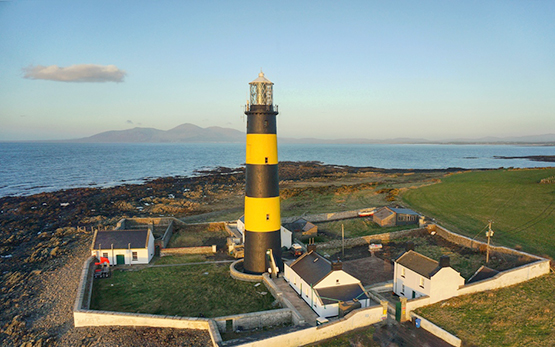
Sentinel of the East Coast – St John’s Point in County Down with the Mountains of Mourne beyond
There are of course many more than just four boats in the area as the Volvo Round Ireland Race 2016 continues on its way. And far to the north, there are other boats which have been hung up in the strongest tides in the Rathlin Island area, and they probably deserve a report to themselves. But really, all they’ll want to do is get on with it again as the tide finally turns again in their favour around 1900hrs.
At this stage of the race, however, followers of the fleet have identified these four particularly interesting crews and boats of broadly comparable size still racing. And in these final stages of the biggest Round Ireland Race ever, it’s fascinating for race addicts to see how they play their hands as the game draws to a close.
The four boats, with their IRC ratings in brackets, are Paul O’Higgins new JPK 10.80 Rockabill VI (1.046), Dave Cullen’s J/109 Euro Car Parks (1.016), Patrice Carpentier’s Sunfast 3200 GROUPE 5 (0.995), and Stephen Quinn’s J/97 Lambay Rules (0.971).
In terms of distance from the finish they’re widely spread, as Rockabill is 58 miles from Wicklow, Euro Car Parks is 67, Groupe 5 is at 80 miles, and the smallest one, Lambay Rules, is 102. Thus it must hardly seem a race at all to anyone accustomed to the One-Design scene. But believe me, there’s a ding-dong going on out there, and from now to the finish at Wicklow some time tomorrow, it’s neck-and-neck on the figures, even if they’re barely in sight of each other.
Currently in the overall placings, allowing for the fact that both Rambler 88 (George David) and Teasing Machine (Eric de Turckheim) are well finished in first and second and secure in their placings, this Battle of the Bulge has GROUPE 5 in third overall, Euro Car parks is fourth, Lambay Rules is sixth, and Rockabill VI is seventh.
Out in a race of her own well to the south is the fourth-placed boat, Michael Boyd’s much larger First 44.7 Lisa. But although Lisa has been milling her way at a fine pace towards the finish line all through the afternoon, at a position 7 miles east of the Baily on Dublin Bay she is about to run out of favourable tide with 22 miles still to sail to the finish. And though the M2 weather-buoy ten miles to the eastward is still showing 12 knots of good southerly breeze, inevitably Lisa’s crew are going to have a difficult evening of it with a foul tide and winds all over the place off Wicklow itself.

By contrast, the smallest boat in our select group, Stephen Quinn’s Lambay Rules (pictured above), is off the southeast corner of Belfast Lough, and the new flood tide which is going to hinder Lisa in St George’s Channel will be a favourable tide for Lambay Rules. It will give her a mighty push through the remainder of the North Channel and out into the Irish Sea, where her three closest rivals are already working on tactical decisions which will stay with them for the remainder of the race.
Leader of the pack Rockabill VI is close-hauled on port well off Carlingford Lough, hanging in very well with Chris and Patanne Power Smith’s J/122 Aurelia, which is tough on Aurelia but good news for Rockabill. Next in line is Euro Car Parks, which hugged the coast more on the leg from South Rock Light to St John’s Point, but is now striking out in open water in some style, though on the 1800hrs fix, Rockabill is shown as slightly faster.
Early in the afternoon. Patrice Carpentier on the two-handed GROUPE 5 became disenchanted with staying with the rest of the fleet as they held close along the shore from the South Rock to St John’s. So he took what now looks like a flyer on starboard, but it may have been a good one, as he’s back on port and making a useful 6.2 knots.
GROUPE 5’s low rating puts her very much in the frame, as too does the even lower rating of Lambay Rules which is currently off Ballywalter showing only 4.9 knots over the ground, as the tide has still to turn. It’s very much Game On for a long night. We’ll take up the story again with our next report in the morning.
See Round Ireland tracker here and keep to up to date with the fleet's progress with Afloat's regular Round Ireland 2016 updates here
Day 5 1000: With Eric de Turckheim’s beautifully-sailed A13 Teasing Machine finally finished in Wicklow at 0859 this morning to retain her second overall in IRC in the Volvo Round Ireland Race 2016 writes W M Nixon, the current outstanding feature of the race is the huge gap between the group of boats currently approaching Wicklow, and the bulk of the rest of the fleet well back to the north, sailing off the County Down and County Antrim coats.
Like it or not, tides are what it’s all about that this stage. First time Round Ireland racers sometimes find it difficult to get their heads round the fact that at the south end of the great pond which is the Irish Sea, the ebb tide runs south through St George’s Channel. But at the north end, it runs north out through the North Channel.
For anyone simply looking at an Irish Sea chart, it’s bleedingly obvious that this is the only way it can happen. But of you’ve done your early sailing years on the shores of either channel, the directions of the local flood or ebb will inscribed in your childhood mind. Yet with the narrow sea-level outlook and weather-obsessed mindset which participation in the Volvo Round Ireland Race induces, there are times when tired sailors, and sometimes even their awfully sagacious navigators too, find themselves having to make a conscious effort of memory to clarify the way the flow will be going.
However, after the fourth night of racing - much of which has seen the bulk of the fleet sailing their little hearts out between Rathlin Island on Ireland’s northeast corner and the finish line at Wicklow Harbour 150 miles away to the south - we can be reasonably sure that an awful lot of people now have the directions of relevant tidal streams centrally inscribed in their thinking. Because since about 0130hrs, the was roaring north for six hours against the fleet in the North Channel. But away to the south, those boats which had managed to get themselves to the latitude of Skerries found themselves on an increasingly positive magic carpet of south-going ebb tide which helped to overcome the adverse effects of light headwinds, and carried them down to finish at Wicklow in time for breakfast.
The result is a huge gap in the fleet still racing. Indeed. there’s only one boat to be found in the 65 miles between County Wicklow and Dundrum Bay, and that’s Joy Fitzgerald’s Class 40 Concise 2 (pictured below) about twenty miles due east of Lambay, second in Open 40 and making good better than 7 knots to windward even if the new flood tide is increasingly slowing progress towards the finish 32 miles away.

There is then a clear gap of 40 miles and more back to the next boat, Michael Boyd’s First 44.7 Lisa (pictured below). But despite the night’s foul tide which moved crewman Paddy Boyd to send us an 0400 text outlining the challenge they faced, Lisa has long since managed to break clear of the narrow bits of the North Channel, and her target now will be to get to the latitude of Skerries in time for the new south-going ebb around 1400hrs.

Meanwhile she continues to lie second in IRC 1 and fourth overall, but seventy miles away at Wickow, Teasing Machine’s race is finally finished, and a great race it has been too. Since midnight her crew had been playing a cat-and-mouse game down the Dublin and Wicklow coasts with Ross Hobson’s much-larger Open 50 Pegasus. While there’d never been any doubt that Teasing Machine would beat the much higher-rated Pegasus on handicap, the sport was such that beating her boat-for-boat became the target, and Teasing Machine confirmed herself in the on-the-water lead in the final three miles to Wicklow, crossing the line ahead of Pegasus at 0859hrs.
Admittedly it was akin to bear-baiting, as the big Pegasus is in the two-handed division, and aboard her Ross Hobson and Chris Briggs were boggle-eyed with exhaustion. But the crew of Teasing Machine had given their all as well, and if we – just for a moment – discount the celestial performance of George David’s Rambler 88 to claim what is now a fabulous new quartet which includes mono-hull line honours, course mono-hull record, open mono-hull round Ireland record, and overall win on IRC, then we see that Teasing Machine has also done something very exceptional, as the distance gap between her and next in line is big in miles if not in corrected time, so with lighter winds the likelihood is it will get bigger.

That said, maybe we shouldn’t count the Machine’s chickens just yet, as currently the second overall is Patrice Carpentier’s Jeanneau Sunfast 3200 GROUPE 5 (pictured above), which also leads the two-handed division, Clearly this is another exceptional performance in a race featuring many exceptional performances.
It has been a night of extremely challenging conditions in the dark heart of the North Channel, yet out of it GROUPE 5 had done extremely well, and she is currently off the north side of Belfast Lough, making eight knots with 115 miles to the finish with the new south-going flood tide under her. But rather painfully for Irish supporters, two miles astern and sailing at a slightly better 8.2 knots is Dave Cullen’s J/109 Euro Car Parks (pictured below).

The fact that Groupe 5 got through the Cullen boat during the night shows just how crazy a place the Antrim coast can be for racing in headwinds and against the tide. But otherwise things are good for Euro Car Parks, as she has got back to first place in IRC 3. Former IRC 3 leader Rockabill VI (Paul O’Higgins) is currently 8 miles ahead of Euro Car Parks, and getting past Mew Island as we write, but her higher rating has her lying second in IRC 3.
Overall in IRC, the placings confirm Rambler 88’s win, and it’s unlikely that Teasing Machine will be disturbed from her second place, though GROUPE 5 should not be discounted for some time yet, and her potential to upset the rankings will be of interest to the betting fraternity. But as of 0945 the rankings were 1st Rambler 88 (finished), 2nd Teasing Machine (fnished). 3rd GROUPE 5, 4th Cavatina (Ian Hickey), 5th Euro Car Parks, 6th Lisa, 7th Lambay Rule (Stephen Hyde), 8th Tockabill VI (Paul O’Higgins), 9th Bam (Conor Fogerty), 10th Sarabande (Rob Mabley).

The #Cavatina2016 team: Ian, Len, Sean, John, Miah & Billy! #RoundIreland16 #LookAtTheCamera #ShoreCrew pic.twitter.com/VV8lcPrjFv
— Cavatina Irl3861 (@cavatinaireland) June 18, 2016
The arrival of the extremely low-rated veteran Cavatina (pictured above) in the top ten rankings will come as no surprise to seasoned round Ireland observers – it’s the fact of simply being right here at the end of the race which has seen Cavatina record Round Ireland overall wins in times past, and while it’s impossible for her to do it this time round, she is in line for quite a respectable showing nevertheless.
See Round Ireland tracker here and keep to up to date with the fleet's progress with Afloat's regular Round Ireland 2016 updates here
Round Ireland Sailing But at a Leisurely Pace!
As Afloat.ie reported in April, Sailing In Dublin Club yacht Silverwind set out on the first of its fourteen week long cruises around Ireland this summer. Club member Damien Byrne describes his week long cruise with stunning views of West Cork.
After two weekend delivery trips, the first from Dun Laoghaire to Kilmore Quay and the second weekend onto Kinsale, Sailing In Dublin Club’s yacht Silverwind set out on the first of its fourteen week long cruises around Ireland. Each of the fourteen weeks, will see the Clubs cruising yacht manned by different members each week, move around the coast of Ireland. On Saturday the 11th June the first crew of five met onboard the Sun Odessey 35, skippered by club Captain Linda fFrench. Of the five crew Linda, Damien and Ann are based in Dublin with Peter based in Co Clare and Anthony in West Cork. The crew was a mix of seasoned and novice sailors.
Having provisioned on the first day the crew set off for Glandore. On route the Captain, went through the safety procedure and equipment on board and also practiced man overboard procedures. The relatively short trip allowed the crew to become familiar with the boat and allowed some time to find their sea legs. The first night involved anchoring in Glandore on a wet evening and the crew cooked on board.
The following morning was a nice bright morning and allowed Anthony to view his home town from a different angle than normal as the boat left for Baltimore. With the winds from the Northwest the crew faced a beat to Baltimore Harbour. On arrival in Baltimore Bay the crew tied up at the more sheltered Sherkin pontoon at the Islanders Rest Hotel. The Hotel provides great food especially the fish dishes which were enjoyed by all. The forecast for Monday included a small craft warning and the crew decided to stay tied up for the day. This time allowed a full walking tour of Sherkin Island which ended in time to watch the first of Ireland’s games in the Euro championship. As there was other boat crews also tied up there was a big crowd watching the match though many did not appear to be too familiar with the game of soccer!

On Tuesday the crew intended to head for Lawrence Cove on Bere Island via the Fastnet, and after a healthy breakfast, and sandwiches made for the long day ahead, they headed out to sea. The sun shone, basking shark and dolphins were spotted, and the crew got great pictures of The Fastnet (above). However it was turning into a long day of sailing, and with a strong and unfavourable wind and lumpy seas, a mixture of sailing and motor sailing, the crew opted for plan B and headed into the sheltered harbour of Crookhaven and picked up a visitor mooring. It was a glorious sunny afternoon so a picnic of a selection West Cork cheeses was enjoyed on deck. Later the crew blew up the dinghy and headed ashore for dinner. After a drink in the local un-crowded hostelry they headed for the local restaurant which appeared almost empty only to be told they were fully booked out with a bus load of tourists which were about to arrive! The only option was to head back out to the boat for a West Cork culinary breakfast of Clonakinty puddings and sausages which we had intended for the morning.
Overnight the wind dropped and the morning was beautiful and sunny as the crew once again headed for Lawrence Cove marina in Bere Island (below). With a favourable wind they sailed past the Mizen and then as they turned north, resorted to the engine to get to Bere Island before the winds increased later in the day. Being under engine allowed the boat to hug the coast and get close up views and pictures of Mizen Head, Three Castle Head and Sheep Head. On arrival in Lawerence Cove we were met by the friendly marina owner Rachel who provided us with plenty of local information and booked a reservation for us in the Lookout restaurant. Although this restaurant is located at the other end of Bere Island the restaurant operates a free shuttle service to and from the restaurant. All the crew enjoyed a fabulous feed of scallops and fresh fish. The family that own the restaurant were also involved in the salvage of the tallship Astrid (which sank off the Cork coast in 2013) and pictures of the salvage operation are on view in the Restaurant. The crew also walked around the old Navy base which was occupied by the British until 1938. Some of the Navy buildings were used by Glenans sailing school until 1993.
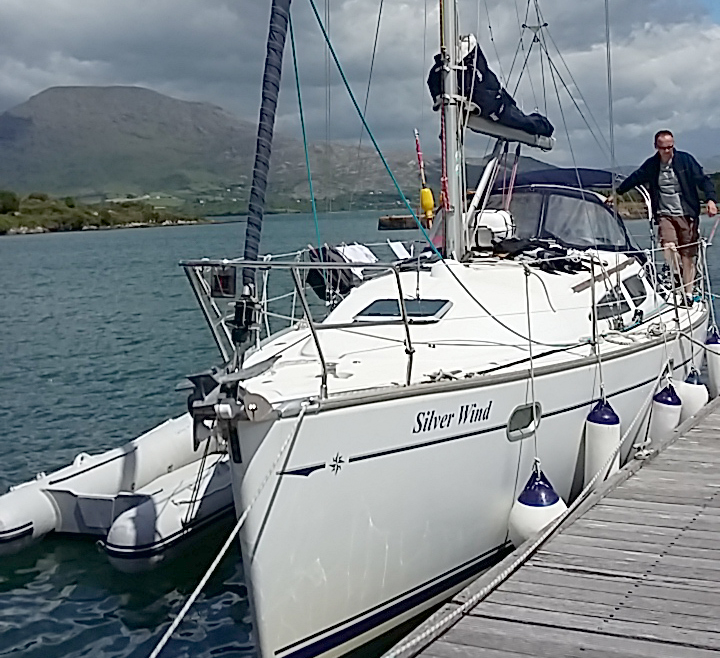
The crew set off the following day for Derrynane. The wind was again strong from a Northerly direction and the crew were very happy to tie up to a visitors mooring in the very sheltered and beautiful harbour. Friday was the last day of sailing and with beautiful sunshine and winds moderating, it turned out to be one of the most enjoyable days sailing. The crew got good views of the coast and of the Skelligs, pods of dolphins swam along with the boat a few times and Fungi the Dingle dolphin also made an appearance when entering Dingle Harbour. After a night out in Dingle with lots of traditional music and craic, all that was left to do was to clean the boat for the next Crew who will bring the boat further on its journey around Ireland.
All in all it was a fabulous week cruise with stunning views of the West Cork and Kerry coastline and Islands, with visits to the more remote parts of Ireland and close encounters with dolphins and basking sharks. Sailing In Dublin Club provides a fleet of boats and the company to sail and cruise in Ireland at very low costs. For more information visit www.sailingindublin.ie






























